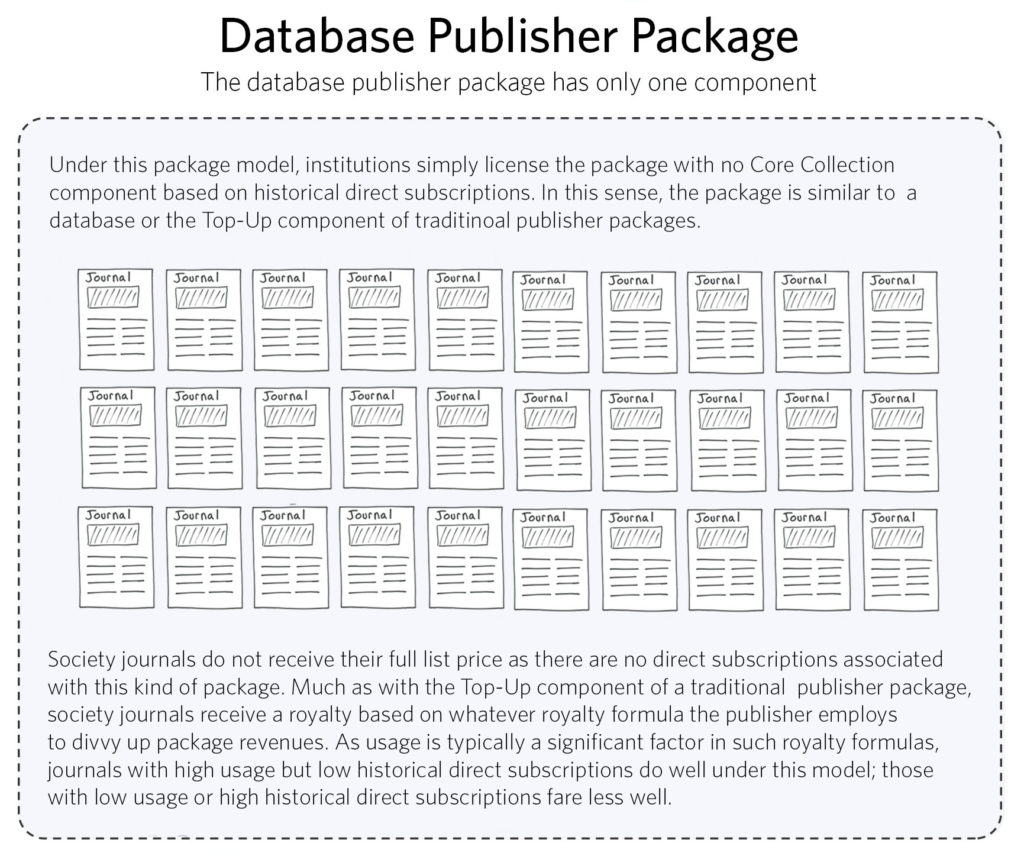For a society that owns journals, partnering with a commercial publisher (or a large university press) has offered a shrewd convergence between the vertical and the horizontal models of publishing. Via such partnerships, societies have been able to participate in the horizontal strategy — benefiting from the economies of scale and bundling strategies (e.g., the Big Deal) of the largest publishers. Shifts over the last decade in how publishers market and sell journals and journal packages, however, have significant implications for society journal valuations over the long term. These same shifts may also be setting some societies up for publisher “lock-in” — making it difficult to change publishers or move publishing back in-house in the future. Only by developing — and actively managing — an astute licensing strategy can societies avoid such lock-in and maximize the benefits of participating in a publisher partnership.
A point of clarification on terminology: Herein the term “Big Deal” refers to any large journal aggregation, including both “all-in” packages (essentially all titles within a publisher’s portfolio) and large subject collections. It does not refer to aggregations by secondary distributors (e.g., packages from EBSCO and ProQuest). Nor am I here addressing the increasing prevalence of ebook packages, which have somewhat different market dynamics.
The Publishing License Agreement
In way of background, it is worth noting a peculiarity of the professional and scholarly publishing industry, which is that so many titles are owned by not-for-profit societies and associations. I am not aware of a parallel in other media segments. This unique circumstance has led to the emergence of the publishing license agreement (also known as a commercial license agreement) whereby publishers can acquire not ownership, but rather the right to publish a given title for a limited period of time (usually 5–10 years) in exchange for paying the society a royalty (typically based on a percentage of revenue with a certain amount of the royalty guaranteed). It is a lease rather than a purchase.
If the journals that are owned by societies were instead owned by commercial entities in the form of smaller independent publishers, they would have long ago been purchased by larger companies. We know this because that is what, in fact, happened with such titles. Elsevier, Wolters Kluwer, Springer Nature, Taylor & Francis, SAGE, and Wiley are all products of various mergers and acquisitions (and at this juncture there are few independent commercial publishers left to acquire). Societies, however, rarely sell their journals. Thus, publishers and societies developed the publishing license as a means of aggregation (for publishers) and asset leverage (for societies).
By entering into a licensing arrangement with a commercial publisher (or another organization, such as large university press or a larger society), societies with professional journals have been able to participate in the Big Deal. There are mutual benefits to this. For the society, it provides three significant benefits:
- Protection from cancellation. Big Deals have historically been structured such that libraries can’t cancel individual titles in the package while maintaining the Big Deal.
- Wider distribution. By participating in a Big Deal, a society’s journals will immediately be available to all customers of the package. Most societies do not have the scale to field the kind of sales network needed to successfully sell their titles around the world. Hitching a ride on a Big Deal has proven advantageous for the distribution of many societies’ titles, which is widely viewed as a benefit to the mission of the society.
- Increased revenues (potentially). The Big Deal allows societies to protect their existing revenues from cancellation and receive incremental new revenues based on inclusion of the journal in the broader package. I say “potentially” as the new revenues must be weighed in context of the entire economics of working with a commercial publisher versus self-publishing.
For a large publisher, the inclusion of society journals in its packages is likewise beneficial, providing:
- High-value content. Society journals are often well-established brands that, in aggregate, make must-have packages even more must-have. There are few options for adding high-quality content to publisher packages at this point beyond the society titles, as there are few well-established brands left to acquire and starting new subscription journals is difficult in today’s mature market. Society journals can be slotted into a package and bring instant value — as well as an engaged society membership that will increase usage of the publisher’s platform.
- Increased economies of scale. Key to the (horizontal) strategy of commercial publishers is building economies of scale, which cut across sales, marketing, technology, and production. More titles improve scale effects and ultimately publisher margins.
- New revenues. Historically, new titles have brought new revenues to the publisher. The publisher is able to transfer all subscription and other revenues to itself (paying a royalty back to the society), thus immediately improving its top line.
Even as more societies flock to publishing licenses with the large publishers, the alignment between publishers and societies has become less than perfect. To understand why, it is necessary to go a bit into the weeds with regard to how Big Deals are priced and sold.
Pricing and Packaging the Big Deal
The Big Deal began as a package of journals very much rooted in the collections histories of licensing institutions. Before the Big Deal, libraries subscribed to various individual journals from a given publisher. Each title had a listed subscription price and that was that. When the Big Deal came along, the situation became more complex. Because many journals in a package are owned by various societies (and because even journals proprietary to the publisher typically maintain separate financials), publishers could not simply license to libraries all the journals in a package at a bulk discount applied to every title (e.g. 15% off each title), because that would disadvantage stronger journals with historically broader circulation. The way the publishers got around this was to sell packages on a “top up” basis (see below figure), whereby the library would continue to subscribe to currently subscribed journals at full price but would also get all the rest of the journals published by that publisher (or offered in a given collection) for a relatively small additional fee (the amount varies based on how much content in the package the institutional already subscribes to).
In way of illustration, let’s say that the Journal of Unstable Chemistry (JUC) is an independently published society journal that has 1,000 institutional subscribers, each paying $1,000. The society that owns the journal — the Bedfellows of Obtuse & Obsolete Methods (BOOM) — then enters into a relationship with a publisher. The publisher adds JUC to its Big Deal. Those 1,000 institutions continue to pay $1,000 each for JUC, except now that $1,000 is paid to the publisher instead of the society (the publisher later cuts the society a royalty check according to the terms of their publishing license agreement). But here is the magic of the Big Deal: in addition to the 1,000 institutions that directly subscribe to JUC and already license the publisher’s Big Deal, the publisher has another 5,000 institutions that license its Big Deal (but do not subscribe to JUC). So JUC continues to be distributed, at the same price, to its 1,000 direct subscribers but now is available in a total of 6,000 institutions. Further, the society derives some additional revenue for usage of its content via the top-up component of the package (the 5,000 institutions that receive the package but do not subscribe directly to JUC). While the revenue from these packages is much less on a per-institution basis than the society receives from direct subscriptions to the journal, it is found money for the society.
Revenue Portability and Publisher Lock-in
The problem for societies that participate in such packages is that revenue from package sales is not portable. Institutions that did not historically subscribe directly to the journal are licensing the publisher’s package. This matters because if the society leaves Publisher A at the end of its contract and enters into a new publishing license agreement with Publisher B, the revenues the society receives each year related to package sales via Publisher A do not transfer to Publisher B. This is in contrast to direct subscriptions to the journal, which are entirely portable (institutional subscribers simply pay the new publisher for the same subscription).
The corollary to this point is that institutions that subscribe to a journal via a package, have no money freed up to direct from Publisher A to Publisher B when a journal transfers between these two publishers. Publisher A does not reduce its package price when a society journal leaves its portfolio. Publisher B therefore is constrained in raising the price of its packages when a new journal is included.
This matters for two reasons:
- Publishers have focused their marketing efforts on package sales. While publishers still sell direct (à la carte) institutional subscriptions, that is not what publishers are focused on selling. Over time, therefore, most society journals experience erosion of direct subscriptions. This can occur as institutions that do not purchase the publisher’s packages (and hence do not have a contractual obligation to maintain direct journal subscriptions) cancel subscriptions for various reasons. It can occur as institutions migrate between various publisher packages. It can also — importantly — happen if institutions cancel their packages to migrate to access via consortia deals. Because publishers are not actively marketing direct subscriptions, subscriptions lost over time are seldom replaced with new subscriptions.
- Package restructuring. Some publishers have begun to restructure packages sold to certain institutions such that there are no direct subscriptions (see below figure). While the historic model of package sales required institutions to maintain direct subscriptions in order to be eligible for package discounts, packages sold by some publishers dispense entirely with the notion of direct subscriptions — the institution is simply licensing the package (as if it were a database and not a collection of specific titles). While this makes perfect sense from a publisher and market perspective (it is the quintessence of the Big Deal), a society journal in such a package will experience an acceleration in subscription erosion when institutions migrate to such database-like licenses
The result of these factors is that many society titles with commercial publishers are seeing a net decrease in direct subscriptions. In many cases, revenues from participation in publisher packages have made up for this decline in revenue. A society looking at financial statements from their publisher may very well see stable or even modestly increasing revenues even while their direct subscription numbers are declining. This is not a problem until the publishing contract comes to an end.
Because revenues from package sales are not portable, other publishers that a society might consider working with cannot factor such revenues into their financial calculus in assessing the value of the society’s journal. When a society’s publishing contract is nearing its end, many societies choose to issue a “Request for Proposals” (RFP) to multiple publishers to ensure they are continuing to receive a competitive financial deal. The problem is that in many cases, direct subscriptions — the primary source of revenues for many journals — have declined. Hence the journal’s value in the market declines.
This can lead to publisher lock-in, where so much of the value of the journal is tied to non-transferable revenues from a specific publisher’s packages. The incumbent publisher in such cases knows that other publishers are not likely to field offers that exceed what the society is earning now. Therefore, the incumbent publisher can make a more modest offer to renew the society’s contract than they otherwise might have made if more of the journal’s revenue was portable (see below figure).
Note this scenario is less pronounced in situations where a journal has substantive commercial sales (e.g., advertising, reprints, permissions). There are a small (and decreasing) number of journals, primarily in clinical medicine, where commercial revenues — which are entirely portable — can exceed that of subscriptions. Some journals also have (typically) modest revenue streams from page charges or article processing charges (APCs) for hybrid journals. And while this last category (APCs) is growing for many journals, the European library consortia are trying very hardto make this revenue stream less portable for society titles. The so-called “Read and Publish” model being promulgated by European national consortia seeks to link subscription and APC payments, capping total payments to a given publisher by an amount negotiated in advance. The result of this model for societies is to re-create the same dynamic of publisher lock-in for APCs as they are grappling with for subscription packages. The Read and Publish model creates an APC package that transfers value from specific journals to publisher packages.
Value Migration and Content Licensing Strategy
The structure of the market has shifted, with value migrating from individual titles to packages — and publishers (not societies) own those packages. There are no easy solutions. On the one hand, journal packages are becoming increasingly problematic vehicles for society journals. On the other hand, staying out of packages is also problematic. For societies that work under a publishing license agreement, not participating in at least some of that publisher’s packages may, practically speaking, result in leaving (sometimes a considerable amount of) money on the table. Further, unless the publisher agrees to actively promote the society’s journal(s) outside of the package, it not clear that a society would have anything to gain by abstaining from package participation. There are a small number of prestigious, must-have journals that are able to make a go of it outside of publisher packages (or with very limited, carefully managed package exposure), but for the vast majority of society publications currently participating in publisher packages, leaving is not a realistic option.
I hasten to add, these are structural challenges that are inherent to any bundling strategy — not just with regard to professional and scholarly publishing. Television networks participating in cable television bundles face similar dynamics, as do recording artists participating in streaming networks. Content owners must determine at a given point in time whether participating in a given package, under the terms they are able to negotiate, is preferable to a different package (either from the same publisher or a different one) or no package at all. Societies working with publishers are no different in this respect, though of course each market has its own important nuances
For societies working with a publisher (or considering doing so), developing a content licensing strategy is essential. Questions to ask in developing such a strategy include:
- How can we best actively manage package participation to both optimize current revenues and preserve long-term asset value?
- How do we develop—and preserve—portable revenue streams that will preserve long-term asset value?
- How might we preserve the portability of APCs in the face of emerging Read and Publish deals?
- How do we develop alternative media properties that further diversify our revenue streams (e.g., Gold OA journals, education products)?
- How do we incentivize marketing and sales of direct institutional subscriptions?
- What information (from publishers or from other sources) do we need to inform our content licensing and negotiating strategy?
This last point bears emphasis, as societies face an asymmetrical negotiation with publishers. Publishers are aware of how comparable titles perform in their packages and have developed detailed financial projections based on a much broader set of data points that span their entire portfolio. They also know what a journal is worth to their package. How much is being more “must-have” or entering a new (to the publisher) field of knowledge worth in terms of package sales, renewals, and pricing leverage? While some aspects of negotiation will always be asymmetric, societies can rebalance the playing field through research, careful analysis, and periodically issuing a competitive RFP.
Given the ongoing changes and complexity of the global market (with different countries pursuing different policy aims), there is neither a monolithic nor a permanent strategy. Moreover, the dynamics are different for each society: journals have a wide range of package exposure and varying levels commercial sales, APCs, page charges, and other revenue streams. Further, journals have different roles in different societies. In some societies, journals are the primary revenue stream for the organization. In other societies, journals are primarily viewed through a “mission” lens and may contribute little revenue (or even operate at a loss). Each society will need to develop a content licensing strategy for its unique set of circumstances and revisit the strategy with regularity as circumstances change — at least in preparation for the renewal of its publishing license agreement or upon consideration of entering into the first such agreement. A key consideration of any such strategy is the preservation of long-term value: when negotiating any content license, one must evaluate not only the short-term benefits but how the deal positions the organization for the next deal.
Go to Article






